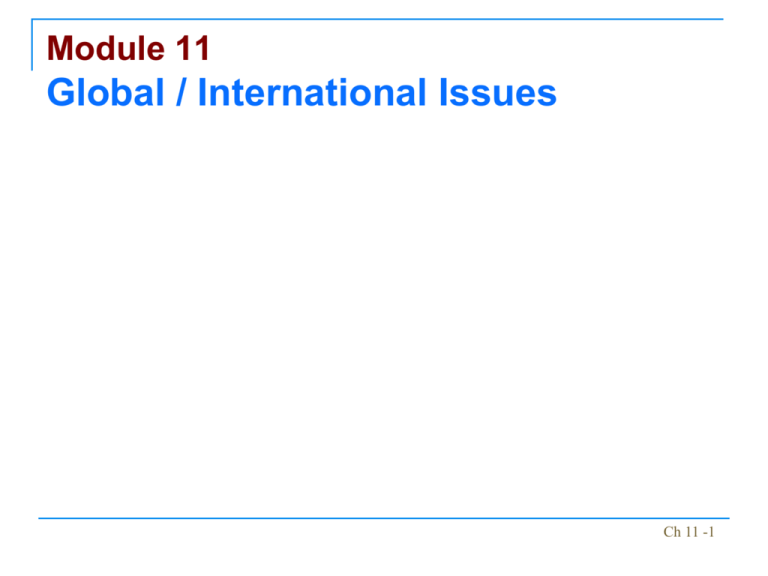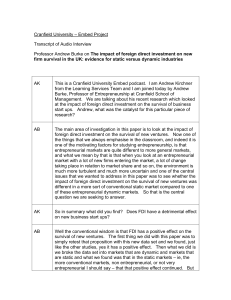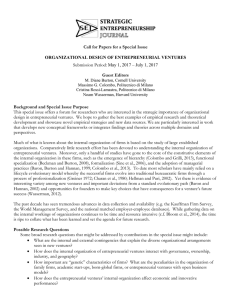Global & International Business Issues Presentation
advertisement

Module 11 Global / International Issues Ch 11 -1 Ch 11 -2 Global/International Issues “Sad but true, U.S. businesspeople have the lowest foreign language proficiency of any major trading nation. U.S. business schools do not emphasize foreign languages, and students traditionally avoid them.” - Ronald Dulek Ch 11 -3 Global Issues Global considerations impact virtually all strategic decisions A world market has emerged It is difficult for a firm to survive relying solely on domestic markets Ch 11 -4 Multinational Organizations International firms or multinational corporations face many complex variables: Social Cultural Demographic Environmental Political Governmental Legal Technological Competitive opportunities and threats Ch 11 -5 Potential Advantages of International Operations Gain new customers Absorb excess capacity, reduce unit costs, and spread economic risks Allow firms to establish low-cost production facilities Competition may be less intense Ch 11 -6 Potential Advantages of International Operations continued Reduced tariffs, lower taxes, and favorable political treatment Joint ventures can enable firms to learn new technology, culture, and business practices Economies of scale Power and prestige in domestic markets may be significantly enhanced Ch 11 -7 Potential Disadvantages of International Operations Foreign operations could be seized Different and often little-understood social, cultural, demographic, environmental, political, governmental, legal, technological, economic, and competitive forces Weakness of competitors overestimated Different language, culture, and value systems Understanding of regional organizations needed Dealing with two or money systems Ch 11 -8 The Global Challenge How to gain and maintain exports to other nations How to defend domestic markets against imported goods Ch 11 -9 Changes in the Global Economy Corporations are obtaining customers globally Markets are shifting rapidly and converging in tastes, trends, and prices Innovative transport systems are accelerating transfer of technology Nature and location of production systems are shifting Ch 11 -10 Protectionism Countries imposing tariffs, taxes, and regulations on firms outside the country to favor their own companies and people Ch 11 -11 Reasons for Global Expansion Advancements in telecommunications Growth in demand for goods and services outside the U.S. is considerably higher than inside 95% of the world's population lives outside the U.S. Ch 11 -12 Globalization Globalization: The process of doing business worldwide Global strategy includes considering global needs during Design Production Marketing Ch 11 -13 A Weak Economy Recession Two consecutive quarters of a decline in real gross domestic product Many countries have recently experienced a recession Unemployment rates are high across the U.S. and around the world Ch 11 -14 Cultural Differences Time Space Family roles Religious factors Family time Values Eating Rules of etiquette Importance of relationships Ch 11 -15 European Business Cultures Participatory management Most workers are unionized More frequent vacations and holidays Guaranteed permanent employment common Workers often resent pay for performance, commissions, and objective measurement and reward systems Ch 11 -16 Asian Business Cultures First names are not generally used in business Extended periods of silence are important A sale is the beginning, not the end of a relationship Resting, listening, meditating, and thinking are considered productive Ch 11 -17 Mexican Business Culture Low tolerance for adversarial relations or friction at work Employers are paternalistic Workers do not expect self-expression or initiative at work Businesses stress collectivism, continuity, cooperation, belongingness, formality, and doing exactly what you are told Rarely entertain business associates at homes Ch 11 -18 Mexican Business Culture continued Preserving one’s honor, saving face, and looking important are valued Opinions expressed by employees are often regarded as back talk Supervisors are viewed as weak if they explain the rationale for their orders to workers Mexicans often do not follow rules Life is slower in Mexico, tardiness is common Ch 11 -19 Japanese Business Culture Importance of group loyalty and consensus called “Wa” Constant discussion and compromise Silence is a plus in formal meetings When confronted with disturbing questions, managers often remain silent Managers are reserved, quiet, distant, introspective, and other oriented Ch 11 -20 Communication Differences Across Cultures Italians, Germans, and French do not soften up executives with praise before a criticism Israelis are accustomed to fast paced meetings British executives complain that Americans chatter too much Europeans feel that they are being treated like children when asked to wear nametags Ch 11 -21 Communication Differences Across Cultures continued Executives in India are used to interrupting each other In Malaysia and Japan periods of silence are appropriate, no silence is needed in Israel “How was your weekend?” is considered intrusive by many business people Ch 11 -22 Worldwide Tax Rates US and Japan 38% Asia-Pacific Region 30% Germany 30% Great Britain 28% France 27% Europe 26% Ireland near 0% Former Soviet-Bloc nations near 0% Ch 11 -23 India Debt is 80% of GDP Gap between rich and poor widening Middle class is growing Ch 11 -24 Joint Ventures in India Joint ventures are mandatory for foreign companies doing business in India Foreign firms restricted to 74% ownership of India-based firms Most joint ventures in India fail Ch 11 -25











